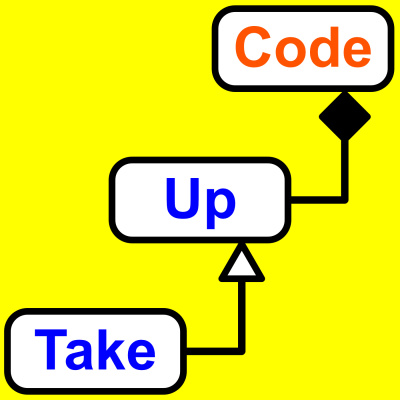Sinopsis
Take Up Code is a podcast that explains computer programming topics through fun and engaging examples that you can relate to. The guided format allows you to gain valuable understanding of topics that will reinforce your studies, allow you to train new skills that you can apply on your job, and change your thinking about what it takes to become a professional programmer. The episodes are as short as possible so you can squeeze them into your daily routine.
Episodios
-
81: Design Patterns: Visitor.
30/03/2016 Duración: 12minThe visitor behavioral pattern allows you to perform actions on a collection of different types where the actions depend on the types.
-
80: Design Patterns: Template Method.
29/03/2016 Duración: 11minThe template behavioral pattern allows your derived classes to change certain aspects of the base class behavior without needing to rewrite everything.
-
79: Design Patterns: Strategy.
28/03/2016 Duración: 10minThe strategy behavioral pattern allows you to define multiple ways to perform some action and then select the best approach.
-
-
78: Design Patterns: State.
24/03/2016 Duración: 08minThe state behavioral pattern allows you to simplify your code when you have different modes of operation.
-
77: Design Patterns: Observer.
23/03/2016 Duración: 11minThe observer behavioral pattern allows you to be notified of any changes instead of constantly checking.
-
76: Design Patterns: Memento.
22/03/2016 Duración: 08minThe memento behavioral pattern allows you to save and later restore the state of an object even without full access to all properties.
-
75: Design Patterns: Mediator.
21/03/2016 Duración: 09minThe mediator behavioral pattern allows you to define complex object interactions while still keeping each object simple and unaware of the other objects.
-
QA Friday 2016-Mar-18
18/03/2016 Duración: 06minHow much programming do you need to know before you can call yourself a programmer?
-
74: Design Patterns: Iterator.
17/03/2016 Duración: 09minThe iterator behavioral pattern allows you to access objects in a collection or anything that contains multiple items without worrying about how this is done.
-
73: Design Patterns: Interpreter.
16/03/2016 Duración: 08minThe interpreter behavioral pattern allows you to solve common problems by expressing those problems in a simple language.
-
72: Design Patterns: Command.
15/03/2016 Duración: 10minThe command behavioral pattern allows you to represent an action that you want to perform as an object that can be copied from place to place and performed at a later time if you want.
-
71: Design Patterns: Chain Of Responsibility.
14/03/2016 Duración: 08minThe chain of responsibility behavioral pattern allows you to setup a series of possible results that you can initiate from a single location without worrying about what code will provide the result. Usually this pattern describes a single outcome but there can be more.
-
-
70: Design Patterns: Proxy.
10/03/2016 Duración: 09minThe proxy structural pattern introduces another object that your code uses instead of the actual object. This might seem pointless but there are some good reasons why you might consider this.
-
69: Design Patterns: Flyweight.
09/03/2016 Duración: 11minThe flyweight structural pattern allows you to represent more items in your application as class instances without using up all your computer memory.
-
68: Design Patterns: Facade.
08/03/2016 Duración: 08minThe facade structural pattern provides a simplified way for you to interact with a more complicated set of interfaces.
-
67: Design Patterns: Decorator.
07/03/2016 Duración: 10minThe decorator structural pattern allows you to add new behavior to object instances dynamically. That means an object can change its behavior at run time. The interesting thing is that your objects do not even know they have been changed.
-
QA Friday 2016-Mar-04
04/03/2016 Duración: 08minWhat is the rule of three? And related to this: What is the rule of five? And what is the rule of zero?
-
66: Design Patterns: Composite.
03/03/2016 Duración: 08minThe composite structural pattern allows you to build elaborate objects from smaller objects and not worry about how big they get. You can treat your composite objects as if they are all the same.

































